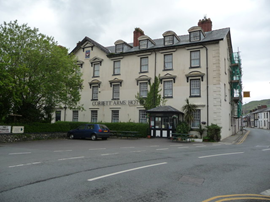Brighton Dome reopens
Brighton Dome’s historic Grade I and Grade II listed Corn Exchange and Studio Theatre have reopened for live performances following a six-year refurbishment.
The work is the first phase of a regeneration project by Brighton and Hove City Council, in partnership with Brighton Dome and Brighton Festival and Brighton and Hove Museums, to cement the Royal Pavilion Estate as a landmark destination for heritage and the arts. The refurbished spaces have been designed by Feilden Clegg Bradley Studios.
The original wooden beams of the Corn Exchange’s timber frame have been repaired, strengthened and restored to designs by the building’s original architect, William Porden, in the early 1800s. The Studio Theatre’s original features, such as crenelated windows that mimic the character of the Royal Pavilion, have been conserved and its ceiling replaced with a new yet historically accurate version. Its exterior has been restored and repaired.
The Grade I listed Concert Hall and Corn Exchange were originally commissioned in 1803 as a stable block and riding house to accompany the Prince Regent’s extravagant seaside palace, the Royal Pavilion. William Porden took inspiration from the Jama Masjid (Friday Mosque) in Delhi for the stable’s exterior, and the glass ceiling of the huge domed roof owed a debt to the Paris Corn Exchange. The dimensions of the riding house were equally ambitious, its 18-metre-wide single span timber roof remaining the largest in the country.
The stables were used as a cavalry barracks until the interior was remodelled as a concert and assembly hall, and reopened in 1867. The riding house reopened in 1868 as a Corn Exchange. In 1934 and 1935, both the Concert Hall and Corn Exchange were refurbished by architect Robert Atkinson. The Concert Hall received a radical art-deco redesign, and the Corn Exchange was repurposed as a single, grand room for exhibitions and functions.
This article originally appeared in the Institute of Historic Building Conservation’s (IHBC’s) Context 179, published in March 2024.
--Institute of Historic Building Conservation
Related articles on Designing Buildings
IHBC NewsBlog
Images from inside a Grade II listed hotel show the scale of its collapse
The Corbett Arms in Tywyn has fallen into serious disrepair.
Old Sarum fire in listed (& disputed) WW1 Hangar - Wiltshire Council has sought legal advice after fire engulfed a listed First World War hangar that was embroiled in a lengthy planning dispute.
UK Antarctic Heritage Trust launches ‘Virtual Visit’ website area
The Trust calls on people to 'Immerse yourself in our heritage – Making Antarctica Accessible'
Southend Council pledge to force Kursaal owners to maintain building
The Council has pledged to use ‘every tool in the toolbox’ if urgent repairs are not carried out.
HE’s Research Magazine publishes a major study of the heritage of England’s suburbs
The article traces the long evolution of an internal programme to research 200 years of suburban growth
IHBC Context 183 Wellbeing and Heritage published
The issue explores issues at the intersection of heritage and wellbeing.
SAVE celebrates 50 years of campaigning 1975-2025
SAVE Britain’s Heritage has announced events across the country to celebrate bringing new life to remarkable buildings.
IHBC Annual School 2025 - Shrewsbury 12-14 June
Themed Heritage in Context – Value: Plan: Change, join in-person or online.
200th Anniversary Celebration of the Modern Railway Planned
The Stockton & Darlington Railway opened on September 27, 1825.
Competence Framework Launched for Sustainability in the Built Environment
The Construction Industry Council (CIC) and the Edge have jointly published the framework.














